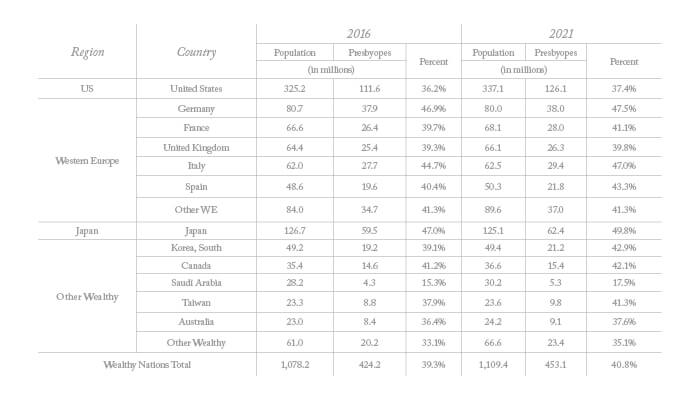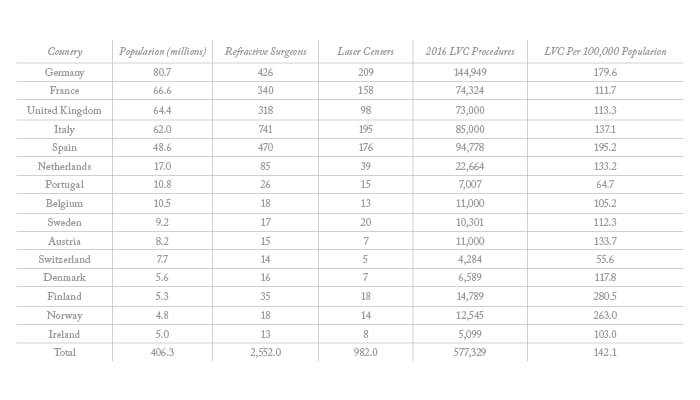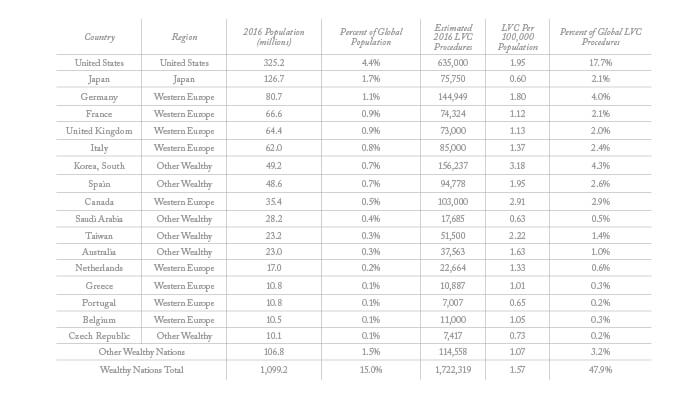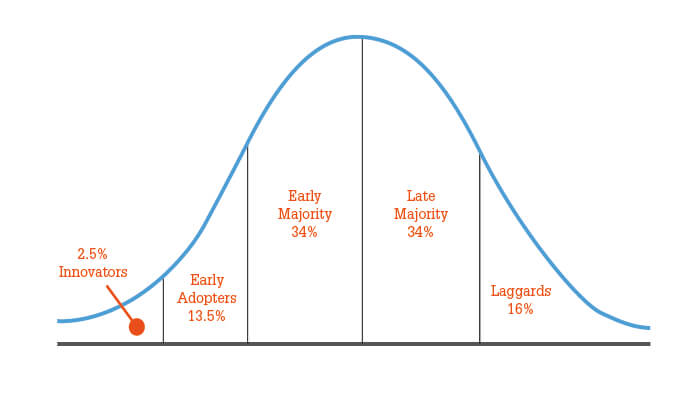
- The refractive surgery market is set to grow in the next few years, but the situation in established markets could be improved
- Negative press about isolated cases in the early days of LASIK surgery has had a big impact on the uptake of laser vision correction procedures
- Educating patients about success and satisfaction rates and good communication, using terms patients understand, are vital for ensuring growth in the market.
According to predictions, global demand for refractive surgery will grow at the compound annual growth rate of 5.5 percent between 2016 and 2021, with patient fees increasing from $5.9 billion to $7.6 billion and annual procedure volume increasing from 3.8 million to 4.9 million. A number of emerging economies are expected to contribute significantly to the global figures, but what does the situation look like in established markets? Myopia and presbyopia are prevalent in societies with high levels of education and literacy, but as surgical abilities and technologies are improving, so are the technologies responsible for producing glasses and contact lenses.
Asia:
- Singapore: up to 80 percent
- China: 77.3 percent in high school, more than 80 percent in college
- India and Malaysia: up to 80 percent
- Jordania: 53.7 percent (ages 17 to 40)
UK: 50 percent of British whites, 53.4 percent of British Asians
United States: 25 percent (ages 12 to 54)
Australia: up to 17 percent
Brazil: 6.4 percent (ages 12 to 59)
The uptake of laser vision correction methods varies greatly among different countries and regions. Within Europe, Finland has the highest percentage of the population undergoing laser refractive surgery (Switzerland has the lowest). The reasons for the differences are complex – social and epidemiological factors are at play, but they might also include patients’ education, surgery availability, pricing, marketing, and the type of healthcare system (private or publicly-funded) in each particular country. Many European countries have long traditions of government-run healthcare systems, so patients are unfamiliar with subsidizing their own healthcare. For the same reason, marketing of healthcare services may look unprofessional, and there isn’t an established “best practice” or advertising standards. Some countries, such as France, restrict such marketing or advertising. Understanding the exact reasons for the disparities between laser vision correction numbers in different European countries is not easy, but it can give some awareness of where opportunities may be for refractive surgery providers.

In the USA, the number of patients with myopia undergoing laser vision correction is almost twice as large as the European average. It is common knowledge that there is a large number of patients who could potentially benefit from laser vision correction, and it is often assumed that financing of vision correction is the biggest barrier for those people. I don’t think this is necessarily the case, especially in Europe, although it might play a bigger part in the decision-making process of potential refractive surgery candidates in the USA.
Oft-asked questions in the refractive surgery space are: is LASIK following the adoption cycle model (Figure 1)? What point of the model are we currently at? Have the innovators and early adopters not been vocal enough in encouraging the potential majority of adopters? Have the efforts to market LASIK to new generations of adopters – people with different habits, values and attitudes – been in vain?
In the early days of LASIK surgery, which also happened to be when the economy was booming, many early adopters – who were presumably not as fearful or worried about potential adverse outcomes – simply “went for it.” And the numbers grew steadily, until a couple of negative stories appeared in the media, discouraging whole communities from undergoing LASIK. Japan is a good example of the downward spiral of bad press: its refractive vision market plummeted overnight because of one bad story in the press. Some of the negative stories come from the very early days of laser surgery, when there were fewer safety mechanisms and procedures that have to be followed. Today, the technology has moved on considerably – but the legacy of those negative stories remains.

Industry insiders have a good understanding of potential outcomes, but members of the public without an in-depth knowledge are not usually particularly good at evaluating risk. The result? The fear factor often wins over high probability of improved quality of life. And that’s why I think the refractive surgery industry has a responsibility to communicate the message responsibly – and in a way that the public can understand.
What can refractive surgeons do?
Communication to potential recipients should be transparent when it comes to your profile – your surgical experience and background – and avoid focusing on low pricing and upselling. After all, patients do realize that the surgeon’s experience and expertise is important. It might also be a good idea to feature the equipment used by your practice on its website, so that you can direct patients to it; in my experience, many people like to have this information available.
I believe the terminology being used in the laser vision surgery market could be another factor that dissuades patients from accessing intervention. Think about it: if you have too much choice, you often don’t end up making a choice at all. PRK, Trans PRK, LASIK, Epilasek, Keyhole LASIK, SMILE, Relex SMILE are all labels being used in the industry. But, in my opinion, all of those should and could be marketed as “laser vision correction,” with an explanation of each possible procedure in the small print. I do not think that practices should use the labels to encourage patients to spend their money on a particular type of surgery, but nowadays there are instances of LASIK being presented in a negative way to promote SMILE, as one example. Such behavior does not help the industry as a whole. There are advantages to each procedure, and they should be individually discussed with each patient, not brought up to upsell a particular type of procedure.
My practice’s website lists the different options on a single page called: laser eye surgery. Categories based on different types of surgery give more detail on what exactly happens in each of the procedures. I truly believe that the industry should be working collaboratively to grow the market share, rather than fight for a particular piece of slowly growing market.
Our focus should be on long-term patient education, not short-term confusion over which type of laser vision correction to choose.
Promoting satisfaction, educating patients
The published reality of modern laser vision correction allows for an almost evangelical approach to patient satisfaction. Some excellent and very large studies put the satisfaction level at 99 percent for laser vision correction as a whole. And let’s face it:
99 percent satisfaction for a surgical procedure is unbelievably high, when considering that it covers the whole psychological spectrum of people, including those who will never normally be entirely happy with any outcome. Such figures show just how much of an impact this type of correction has on people’s quality of life. Additionally, the risk of complications is very low, compared with using contact lenses, but that is not the message that surgery candidates are receiving.
Patient education is extremely important. In the past I had occasionally received negative comments from my colleagues about the way my practice used to market for example on social media. But what they perhaps failed to realize is that I was never talking to them nor trying to convince other surgeons (that’s what conferences and other events are for!) – instead, whether on my website or during consultations, I was communicating with people who might not be medically or scientifically educated. It makes sense to find and use language that speaks to our patients – a way of communicating that works for them rather than bemusing them.
My take home message? Our field is one to be proud of, and I truly believe that we must unite in our efforts to boost the number of patients benefiting from laser vision correction.

